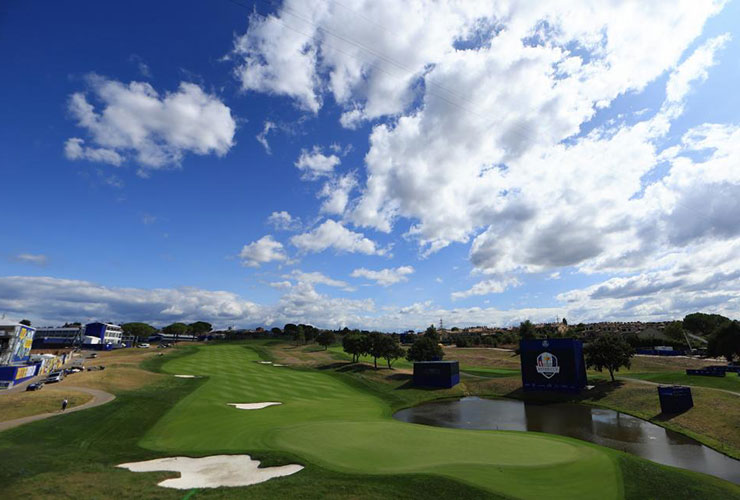There is a pasta truck, which is next to a cocktail truck, which is next to a pizza truck, all parked 50 yards from the eighth fairway. If you’re looking for our primary takeaway from our initial walk around this week’s Ryder Cup venue, Marco Simone, that is what comes to mind. Which, frankly, is exactly what you want from a golf event just outside of Rome. Travelling this far for a hot dog doesn’t seem right.
OK, there were golf insights, too. Though Marco Simone is the host of the DP World Tour’s Italian Open, most of the American audience will see it for the first time this week. Following our trek around the course Monday, here are eight observations for what to expect from this year’s Ryder Cup home:
Familiar feelings
Marco Simone is not short on scenery, the property offering beautiful vistas of the Italian countryside, olive groves, rustic villages and the Roman skyline. But decouple the views from the course and two comparisons come to mind. The front nine at Marco Simone has the shape and styling of Liberty National, a maximalist and artificial design that puts a premium on ball-striking. The green contours are severe, and if the surfaces are not slow and wet they’ll reject any approach less than right. The routing is compact. There’s a sense the club tried to fit nine holes into an area that has room for just seven. The back nine, however, is far more expansive in scale. Its topography is dramatic, yet the greens are less punishing. While the back nine still can present its difficulties, it seemed fairly gettable. In that vein, it has an air of Valhalla to it.
A bit of breathing room
No, it’s not Whistling Straits with fairways wide enough to land 747s with ease. But the test Americans will encounter at Marco Simone is nowhere near as suffocating as Le Golf National was off the tee (more on this in a moment). The landing areas are generous, and though there are a handful of par 4s with narrow confines — which include bunkers coming into play — those spaces are usually stifling only for long drives. However …
The rough is very grabby … and patchy
It appears the long stuff has been dialled back from the scouting trips each team made a few weeks back. That said, it still looks to be a nuisance in a way most US Ryder Cup set-ups are not, and the ball could have the chance to burrow in the high stuff. As inviting as most of the fairways are, Marco Simone will make a player pay for his miss. That includes around the green. However, unlike rough that is thick and plentiful — which can subtract creativity and vision from the short game — this grass is uneven (and arguably, unintentionally so). That could lead to more variety, and variance, in terms of the types of shots played and their outcome. Combined with the shaping of the greens, a deft short-game touch will go ways this weekend.
Wind could be a major factor
It’s worth noting the area isn’t too far from the Mediterranean Sea, and its position on the hill makes Marco Simone vulnerable to stiff breezes. On Monday the wind was a constant 10mph with little respite, and the early weekend forecast calls for similar conditions. Should that prediction hold, the currents will shrink some of those aforementioned landing areas, although the wind’s impact will likely be felt more on the approach, a nod to the green’s contours and that many of the greens are elevated.

A general view of the 18th green at Marco Simone. Mike Ehrmann
The greens could be dangerous
Europe has traditionally utilised slower putting surfaces than their American counterparts when it comes to course set-up. They may not have a choice in Rome. The greens are massive, yet their slopes, shapes and curvatures are so drastic that each green is essentially broken into quadrants. Failure to hold the ball in its requisite section will correlate to long, lengthy putts. If the greens have any semblance of pace to them things could get wacky.
The tweener par 4s
Really cool! There are three drivable par 4s on the course, and though the wind can have a say in how they are played, most can be had with less than driver. However, most are also guarded by water, bunkers, rough or fescue, and because they can be reached with a 3-wood, arguably even an iron, this configuration should prevent players from just banging the big stick without thought. Eagles to doubles (or worse) will be very much in play.
First six/seven holes are volatile
“Volatile” is probably a generous interpretation, as critics could argue this stretch borders on gimmicky. Understanding the 24 individuals competing are the world’s best — and thus capable of playing a game unfamiliar to the rest of us — each of the first seven holes have penal aspects to them … sometimes to the shots that the hole seemingly requires. It’s easy to see a few blow-up scores, which could lead to players building a big league early over a struggling opponent.
Last three holes should facilitate drama
This stretch is not for the meek. The last three holes are a drivable par 4 over water, a 200-yard par 3 with an undulating green and a 600-yard par 5 with a greenside lake. (Like we said, a little Valhalla-y.) Assuming matches reach this point, the risk/reward spectrum is vast, which — hopefully! — creates a thrilling ending to each match and session.
Main image: Patrick Smith









